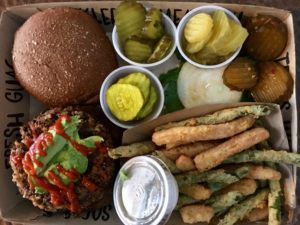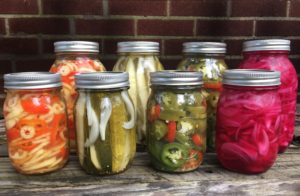By JOHN I. CARNEY ~ jcarney@t-g.com – Times-Gazette

My fermenting jar. At right is the hand-held pump which can be used to pump out the air at the beginning of the process, which helps guard against mold.
T-G Photo by John I. Carney
When I first took a taste of one of my fermented pickles last month, it was a major disappointment. It had an off taste — almost a carbonated, soda-water taste. Oh, well, I thought. Chalk it up to experience.
It turns out I hadn’t been patient enough. In the fridge, over time, the pickles got better and better, and one night last week, when I was looking for a snack and happened to reach into the pickle jar, I was surprised at how much better the pickles had gotten.
First, a word of explanation. Most of the pickles you’ve had in your life, homemade or storebought, have been infused pickles, made with vinegar. There’s nothing whatsoever wrong with infused pickles, and I’ve eaten more than my share. But there’s something special about fermented pickles, which are the original pickles.
Fermented pickles are not made with vinegar. They’re made by soaking vegetables in salt water until the vegetables naturally begin to ferment. This fermentation produces lactic acid, among other things, and this naturally-occurring lactic acid is what gives fermented pickles (or sauerkraut) their tanginess and alters their texture.
At some point, it was discovered that you could produce something similar to a fermented pickle by simply soaking cucumbers (or cabbage, or what have you) in a vinegar-based brine. Those are infused pickles. They’re much easier to make, because you don’t have to fuss over them like fermented pickles. Fermented pickles, after all, live right on the borderline. The salt water keeps them from rotting, while the “good” bacteria that cause fermentation are able to thrive in the salt water.
You can’t seal the pickles up tightly, because the fermentation process creates carbon dioxide, which could build up enough pressure to break the glass jars. And you can’t leave them completely open, either, because mold can form on the surface, where oxygen is present.
The traditional method of making fermented pickles was to use a crock (or a barrel, for larger batches!) with a heavy lid, perhaps combined with some sort of weight so that the pickles stay submerged in the brine. The top of the brine would occasionally have to be skimmed.
At some point, someone invented an “airlock” type lid which could be put on top of a Mason jar. It would let the carbon dioxide out without letting air in, dramatically decreasing the possibility of mold. But those airlocks weren’t easy to find, and they had a very high profile, sticking up several inches from the top of the jar.
I’d always wanted to make a crock of fermented dill pickles. But I never got around to it until, within the past few months, I started seeing ads for a new option — a low-profile lid with a valve to let carbon dioxide out. The lid fits a standard wide-mouth Mason jar, although you can also buy it with its own decorative jar, depending on where you look. Some vendors also sell the lid with a hand-held vacuum pump, which can be used to pump air out of the jar’s headspace when you first seal it up. That helps protect against the formation of mold on the surface of the brine.
Back in July, one of my T-G co-workers left a bounty of cucumbers in the break room, and many of them were the perfect size for dill pickles. I snatched up the smaller cucumbers and went online to order a fermenting lid and jar.
As I said, the fermentation process produces C02 gas. In fact, it’s possible for the brine or even the pickles themselves to take on a little carbonation, which may have been what I was tasting in that first pickle out of the jar. But just as your Coca-Cola eventually goes flat, the carbon dioxide from these pickles eventually dissipates.
I made the pickles with salt, water, fresh dill, dill seed, mustard seed, peppercorns and garlic. No vinegar is necessary because the tanginess comes from fermentation.
The jar is left at room temperature for 3-5 days to jump start the fermentation process — then it’s moved into the fridge. This differs from the directions I’d always seen for a crock, which were to stash it (start to finish) in a basement or the coolest possible area of your home. I don’t have a basement, or air conditioning, and so I was always worried that there wouldn’t be a cool enough place in my apartment.
I had underestimated the importance of letting the pickles continue to ferment over time in the fridge, which is why that first pickle wasn’t up to expectations.
The lid worked like a charm. In the early stages, you could occasionally see tiny little bubbles of carbon dioxide coming out through the valve. I had no problem with mold whatsoever.
Some health food types (and the makers of these new fermenting lids) claim that naturally-fermented veggies (unlike their infused cousins) contain active, probiotic bacteria which can have beneficial effects on your body. I can’t speak to that claim. But I do know there’s something unique and special about the flavor. If you’ve ever eaten a really good pickle at a delicatessen, it may well have been fermented.
The special lid and pump can be used for sauerkraut or other pickled vegetables, not just cucumbers.
I’m anxious to try another batch of pickles — and I’ll be a little more patient next time.
SIDE NOTE: Texas Tito’s pickles are fermented and shelf stable









